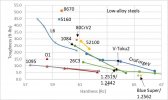- Joined
- Jul 22, 2020
- Messages
- 3
new here but ive been making knives for a few years in northwest arknasas. my question comes to those who have made longer blades with 8670 and how it would react to a clayed differential quench and if it would even be worth it with that steel over a through hardening. (dont care about the hamon but the performance) my plan is to make a wakizashi using 8670 and using the clayed differential quench to give it its curve. i have no idea if this would work as ive never done a sword before but i have made quite a few knives with 8670 and absolutely love the steel. i know i would have to pre form the bend before quench if i through hardened it but will it take a curve in the quench clayed if its straight.

